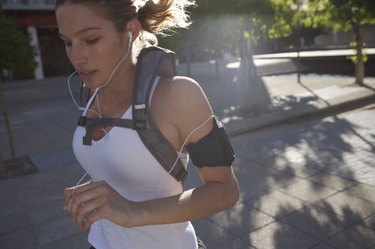
Whether you're running with a weighted running backpack because you want to make your runs a little more challenging or because you want a change from regular running, doing so can be an effective way to get fitter and stronger. As a high-calorie-burning form of cardio, running can help you get in shape. When wearing a backpack, however, it's vital you don't let the added weight alter your technique.
Read more: Trail Running Shoes Vs. Running Shoes
Video of the Day
Video of the Day
Running With a Weighted Backpack
Running with a weighted backpack not only burns more calories, but research suggests it could also improve running performance. A December 2013 article published by the Journal of Science and Medicine and Sport demonstrated improved sprinting speed in trained runners after participants wore weighted vests during running warm-up activities.
Picking the Right Pack
A special running backpack is a must when running. The last thing you need is a big, bulky, cumbersome bag swinging around as you run. Pick a bag that sits snug into your back. Consider buying a pack that has a belt so you can tie it around your midsection to reduce any sway and bounce while running. By keeping the weight around your hips, you're forced to engage your core and glute muscles more than if the bag were swinging around your shoulders.
Refine Your Technique
When running with a backpack, your legs have to deal with extra weight and pressure going through them on every single stride. Shorten your steps to reduce the amount of force through your legs as you run. The temptation will be there to slump forward and use short, shuffling strides. To avoid this, aim to drive down forcefully into the ground on every step. Keep your head looking forward and your chest up, with your shoulder blades pulled back. Brace your core tight and squeeze your glutes as you run.
Read more: Difference Between Jogging & Running
Pack It the Right Way
The last thing you want during a run is the weights in your backpack moving around, digging into your back and causing discomfort. To avoid this, pack the bag as tightly as possible. Rather than just throwing a big weight plate or two in there, use small dumbbells or plates and pack towels or old sweaters around them.
This should keep the pack firm and solid and prevent bruising as you run. Use books or other sturdy household items if you don't have weights at hand. As you get fitter and stronger, you can add more weights in the form of extra dumbbells, plates or books.
Put Your Back Into It
Running with a weighted backpack can be challenging, so start with light weights and short distances and build up gradually. As you become accustomed to the weight and distance, you can either add more weight, run for longer or aim to beat your times. You could even incorporate interval training.
Start with a walk while wearing the pack to warm up, slowly increasing your speed over the course of five minutes. Break into a moderate-paced run and maintain this for 90 seconds, then increase your speed, so you're at roughly an eight-out-of-10 effort level. Stay at this pace for 30 seconds, then ease back to a moderate speed and repeat this protocol six to 10 times.